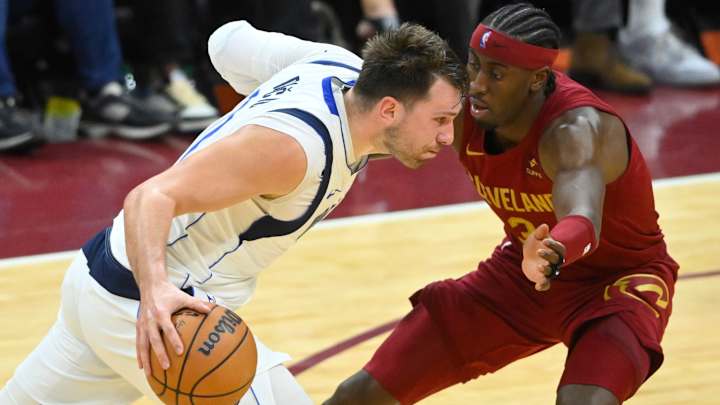SI:AM | NBA Competition Committee Looking Into Offensive Surge, per Report

Good morning, I’m Dan Gartland. I can’t believe there were two half-court buzzer beaters in games last night.
In today’s SI:AM:
🏌️♂️ An elusive pro golfer’s return
If you’re reading this on SI.com, click here to subscribe to receive SI:AM in your inbox every weekday.
NBA scoring is still climbing
It’s easier than ever to score points in the NBA these days—and not just in the All-Star Game. While that farcical showcase in Indianapolis earlier this month generated plenty of hand-wringing about the future of the All-Star Game, the 211–186 final score was really the peak of a trend years in the making.
Scoring has been rising steadily in the NBA over the past several years, to the point where it’s now higher than it has been in over 50 years. But the NBA might be prepared to do something about it.
ESPN’s Tim Bontemps and Kevin Pelton reported yesterday that “the league's competition committee has officially begun reviewing whether the game has tilted too far toward offense and whether changes need to be implemented to achieve better balance.”
“It is a topic that we’re monitoring,” NBA head of basketball operations Joe Dumars told ESPN. “We’re diving in right now to make sure that we're on the right side of this.”
All sports leagues have to deal with issues like this, deciding how to tweak rules to produce the most aesthetically pleasing version of the game that will keep fans as engaged as possible. MLB has done it recently with the pitch clock, changes to the composition of the baseball and banning defensive shifts. The NHL has tinkered with the size of goalies’ pads several times since the 2004–05 lockout. Now, it looks like it could be the NBA’s turn to tweak the dials.
The stats make it abundantly clear that offenses have the upper hand. Teams are averaging 115.3 points per game this season. That’s the highest since the 1969–70 season. Teams are also averaging 115.7 points per 100 possessions, the highest since possession data became available in the ’74–75 season.
A lot of that is because of the analytics revolution and the increase in three-point attempts (teams are averaging 12.8 made threes per game this season, the highest in league history), but that’s not the only explanation. The league field goal percentage is .475, higher than in any season since ’89–90, even though a much higher proportion of shots this season are more difficult three-pointers. (Teams only attempted 6.6 threes per game in ’89–90, compared to 35.0 per game this season.) That suggests that players are getting more easy two-point shots than they have in recent years. In the 10-year period between the 2012–13 and ’21–22 seasons, the league field goal percentage ranged between .449 and .466. Last season, it shot up to .475. The question is how much of that increase can be attributed to lax defense and how much can be attributed to teams eschewing mid-range shots in favor of threes and shots in the paint.
The most visible representation of this new offensive reality has been the rash of explosive individual scoring performances this season. There have been six 60-point games this season, the third most of any season in NBA history. The two seasons at the top of the list were 1961–62 and ’62–63, when Wilt Chamberlain was stuffing the stat sheet. And it isn’t just those ultra-rare scoring outbursts that are on the rise. Players are reaching more attainable scoring totals more frequently. There have been 121 40-point games this season, most recently by Luka Dončić last night. With a month and a half left in the season, that’s on pace to be the second-most 40-point games in a season in NBA history, behind only last season.
So what can be done about this? The easiest potential solution would be for the league to tinker with the rules and roll back the ban on hand checking that it began enforcing about 20 years ago. But a more radical solution might be the best: Shorten the season. If teams played fewer games, each individual game would mean more and players would be incentivized to play harder in those games. Players would also be fresher without having to sit out games for “load management,” and therefore more capable of exerting more effort on defense. It’s not the solution the league wants to hear, but it would work.
The best of Sports Illustrated

- Matt Verderame has updates on the biggest story lines at the NFL combine, including the Chiefs’ plans for the franchise tag and what the Eagles will do with Haason Reddick.
- Albert Breer has more notes from the combine, including his thoughts on how Bears GM Ryan Poles handled questions about Chicago’s quarterback situation.
- Conor Orr is also at the combine, where he wrote about one way the Patriots are moving on from Bill Belichick.
- Chris Mannix has a Q&A with Damian Lillard about how he’s adjusting to playing in Milwaukee.
- Former PGA Tour golfer Anthony Kim, who has not played a pro event since 2012, will play for LIV Golf for the rest of the season.
- One MLB team isn’t having the same uniform issues as the rest of the league. The Royals worked with Nike to use last year’s lettering on the back of the jersey while fans of the 29 other teams squint at the new tiny font.
The top five...
… things I saw last night:
5. Kyle Rose’s game-winning three for Fordham against George Mason.
4. Victor Wembanyama’s effortless block without even leaving his feet.
3. DeMar DeRozan’s 360 reverse layup.
2. Jarod Lucas’s half-court game-winner for Nevada.
1. Max Strus’s game-winner from well beyond half court. (Strus’s 59-foot shot was the second-longest buzzer beater in NBA history.)
SIQ
Luka Dončić, who turns 25 today, has scored the second most points of any NBA player born in Slovenia. Who’s first on that list?
- Beno Udrih
- Goran Dragić
- Toni Kukoč
- Rasho Nesterović
Yesterday’s SIQ: On Feb. 27, 1999, which team became the last in Premier League history to field a starting lineup composed entirely of English players?
- Arsenal
- Aston Villa
- Sheffield Wednesday
- Leeds United
Answer: Aston Villa. In fact, all three of the substitutes who saw action that day for Villa were also English. Villa lost 4–1 to Coventry City.
The lineup included a few names that should be familiar to soccer fans, including Gareth Southgate, the current English men’s national team manager, and commentator Ian Taylor.
Only four of the 24 players who played for Villa that season were not English: Mark Bosnich (Australia), Colin Calderwood (Scotland), Dwight Yorke (Trinidad and Tobago) and Mark Delaney (Wales).
There have been a couple of Premiership clubs in the years since that have come close to fielding all-English lineups. Four times in 2020 and ’21, Burnley’s starting lineup included 10 English players, according to Opta Analyst. The most interesting close call came on May 7, 2006, when Middlesbrough’s starting lineup against Fulham included 11 players born in England. But one of those players, James Morrison, chose two years later to represent Scotland in international play, returning the distinction of the most recent all-English lineup to Villa.
